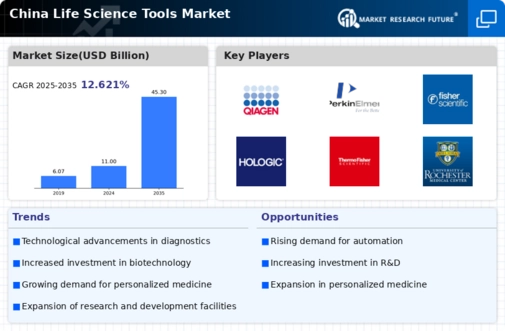Focus on Health and Wellness
The life science-tools market is increasingly influenced by a societal shift towards health and wellness in China. As the population becomes more health-conscious, there is a rising demand for tools that facilitate health monitoring and disease prevention. In 2025, the market for health and wellness-related life science-tools is projected to reach $15 billion, growing at a CAGR of 10%. This trend is likely to encourage the development of innovative tools that support preventive healthcare measures, such as diagnostic devices and health tracking technologies. The emphasis on health and wellness is expected to play a crucial role in shaping the future of the life science-tools market.
Expansion of Research Institutions
The life science-tools market in China is benefiting from the expansion of research institutions and laboratories. The government has been actively promoting the establishment of research centers, which has led to an increase in the number of facilities dedicated to life sciences. By 2025, it is estimated that the number of research institutions will grow by 20%, creating a higher demand for life science-tools. This expansion is likely to foster innovation and collaboration among researchers, ultimately driving the market forward. The increased availability of state-of-the-art tools and technologies will enhance research capabilities, thereby contributing to the overall growth of the life science-tools market.
Rising Investment in Biotechnology
The life science-tools market in China is experiencing a surge in investment, particularly in biotechnology. The Chinese government has prioritized biotechnology as a key sector for development, allocating substantial funding to research and innovation. In 2025, the investment in biotechnology is projected to reach approximately $50 billion, reflecting a growth rate of around 15% annually. This influx of capital is likely to enhance the capabilities of life science-tools, facilitating advancements in genomics, proteomics, and other critical areas. As a result, the life science-tools market is expected to expand significantly, driven by the demand for innovative tools that support biotechnological research and development.
Advancements in Artificial Intelligence
The integration of artificial intelligence (AI) into the life science-tools market is becoming increasingly prominent in China. AI technologies are being utilized to enhance data analysis, improve diagnostic accuracy, and streamline research processes. By 2025, the market for AI-driven life science-tools is expected to reach $10 billion, with a growth rate of approximately 18%. This advancement is likely to revolutionize the way researchers and healthcare professionals utilize life science-tools, making them more efficient and effective. The incorporation of AI into the life science-tools market is indicative of a broader trend towards digital transformation in the life sciences sector.
Increasing Demand for Personalized Medicine
The life science-tools market is witnessing a growing demand for personalized medicine in China. As healthcare shifts towards more individualized treatment approaches, the need for advanced diagnostic tools and technologies becomes paramount. In 2025, the market for personalized medicine is anticipated to reach $20 billion, with a compound annual growth rate (CAGR) of 12%. This trend is likely to drive the development of life science-tools that enable precise genetic and molecular profiling, thereby enhancing patient outcomes. The focus on personalized medicine is reshaping the landscape of the life science-tools market, as stakeholders seek to invest in tools that cater to this evolving healthcare paradigm.





















Leave a Comment